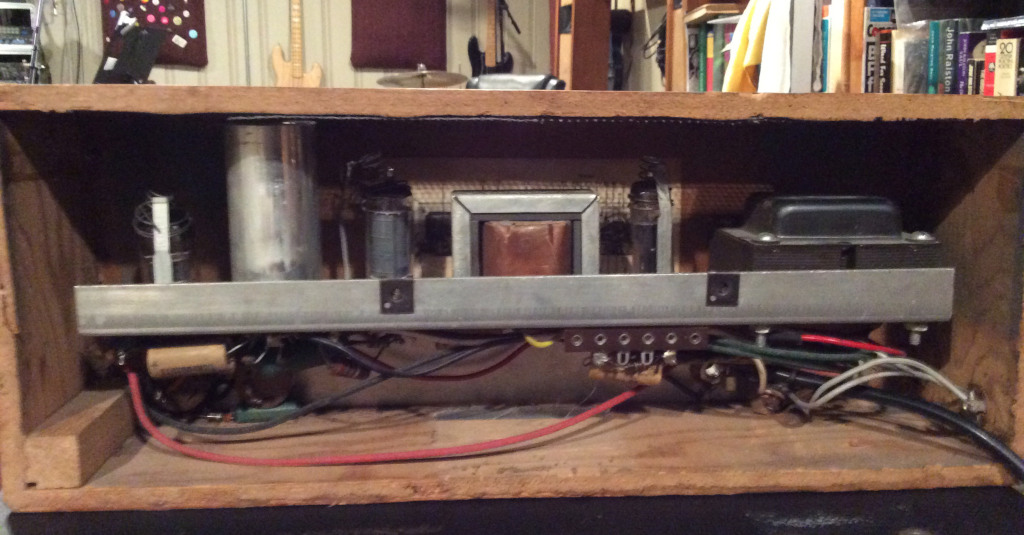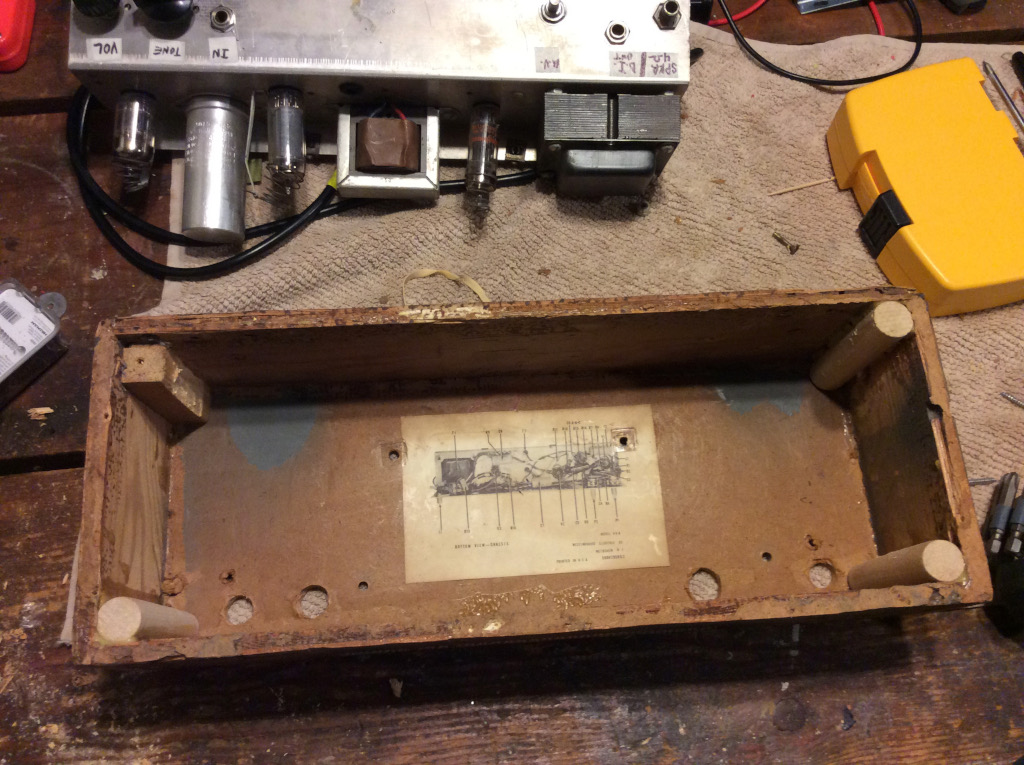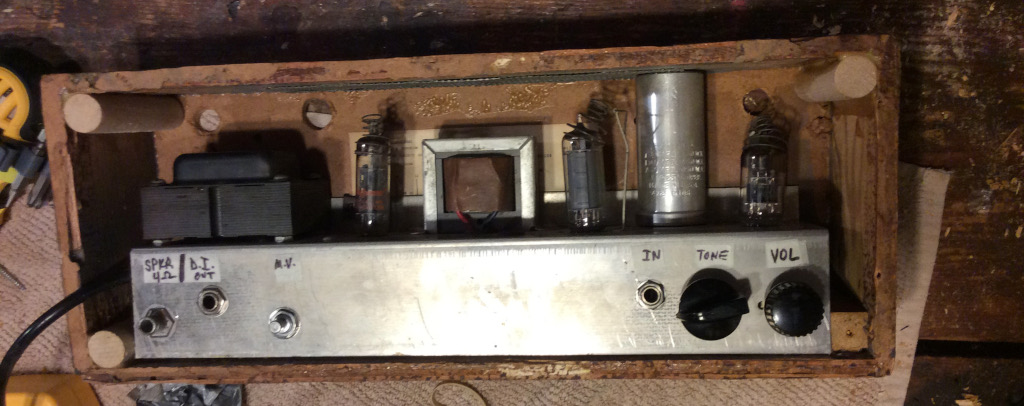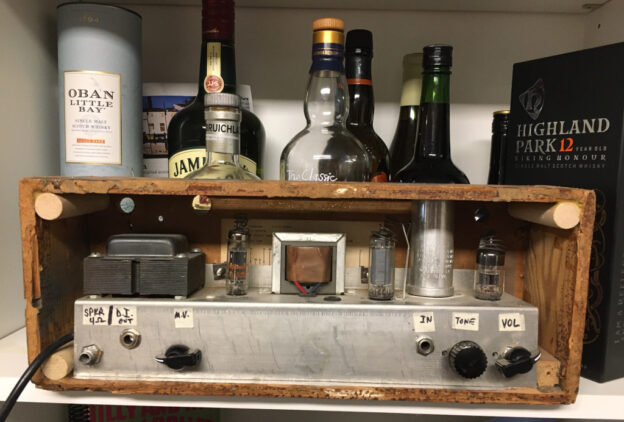There are a lot of cool old amplifiers out there which can be rebuilt into excellent guitar amps. One of my amps, named the “HurtZOMG!” was rebuilt out of an old portable phonograph, and worked out really well. This post is about how it came to be, and what makes it so useful
Let’s start at the beginning, which is
The End Result
The HurtZOMG! is a small, simple, single-sided tube guitar amp, very similar in basic design to a Fender Champ. It has a regular speaker out and a soaked (line level) output that you can plug into the input of another (following) amp or DI box. This allows the HurtZOMG! to act as either a small amp head or as a preamp.
Controls
- Volume (Vol) -This is basically the input gain. It’s a click-on knob that also switches on the input, though the amp is always on when plugged in
- Tone – Also a click-on knob, so you can disable this part of the circuit completely
- Master volume – This knob only affects the output level of the soaked output
Ins and Outs
- Input – instrument in here
- Speaker Out – speaker out here. Min 4 Ohms
- DI Out – to following amp or DI
The Story
Chapter 1: An Old Beginning

I saw an ad on Craigslist for two old tube amps for $35. Neither of the amps had started life as guitar amps, though both were basically the same design as guitar amps.
The amp that became the HurtZOMG! was originally part of an old RCA transcription record player. When the turntable part of the player gave up the ghost, the amp section was removed and fitted into part of the original record-player case. A couple of 1/4″ jacks later, someone had a small and fun little amp head. That was the shape the amp was in when I bought it.
When I got the amp home, I took a look at the tube complement and realized that it was interestingly similar to a Fender Champ.
- 12AX7 preamp tube
- 6CM6 power tube
- 6X4 rectifier tube
The Champ is tube complement is usually 12AX7, 6L6, and 5Y3, but the tube variations in my amp are often used in modifications of Champs and other guitar amps. This little amp would make a good basis for an interesting build.
The Plan
I’ve been a fan of Big Sugar for a while, and fundamental to Gordie Johnson’s huge guitar tone has been the mighty Garnet Herzog. In a nutshell, the Herzog a modified Champ circuit with a soaked output. You plug your guitar in to the Herzog, crank the snot out of it, then run the soaked output into another guitar amp. You can adjust how hard the Herzog output hits your next amp, and enjoy the awesome power of cascaded low- to medium-gain stages.
You can read more about the Herzog here. It’s a pretty cool thing, and you have probably heard one without knowing it.
I figured that I could recycle this cool old amp into a very useful single-ended Champ-like amp head that could also be a device of crunchiness. So that’s what we did.
The Process
After a bit of thinking, I took the amp to Michael Saklar at Echoluxe and told him what I wanted. As always, Michael had some sane advice on how to make this idea better, and then he did the rebuild.
The amp had been glued and jammed into worn-out, smashed piece of the original RCA record player’s cabinet, and Michael had to break that open in order to do the rebuild. As always, his rebuild went very well. Michael kept as many original parts in the circuit as possible, replacing only things wouldn’t work any more, or would have been dangerous to keep.
He also changed the layout around a bit, which improved things, and changed the orientation of the chassis relative to the “cabinet.”
I was absolutely determined to reuse that same crappy “cabinet” the amp came in, so I spent an hour or two cleating and glueing and reinforcing and hacking it all back together.

At some point, I’ll probably cover the whole thing in Tolex, so no-one will know it’s in the original bit of RCA box but me, but dammit I’LL KNOW!

So How Does It Sound?
It sounds GREAT.
As a little amp
Because I am normally a nice, polite fellow, I usually run this though a single, open-backed 12″ speaker. I have used it a lot with both a Celestion Vintage 30 and a WGS G12c/s and with either it sounds big and full and throaty with cleans, but keeps that open uh, squonkiness that we love in small amps.
Because the HurtZOMG! is small and enthusiastic, it works up a bit of a sweat whenever it is running. This means you always get that nice push and responsive-yet-forgiving feel without being as loud as you might need to be with a bigger amp. That sounds like an obvious thing to say, but not all small amps actually work like this, and a lot of them only sound good in a narrow volume range.
it’s very easy to find a sweet spot tonally with just the volume knob on the HurtZOMG!, without getting so loud that the tone blows past you, or can’t be heard at all.
That having been said, it can get surprisingly loud1 and there is a lot of clean headroom. I have used this amp for rehearsals with bands in which I pretty much only play clean guitar, with people who are quite loud (STEVE!) and I could be heard just fine without having to push the amp to a point where it didn’t sound like I wanted it to.
But let’s be honest–clean sounds are not what most people use small amps for–especially if they already own bigger amps.
No, the reason to have a small amp is so that you can turn it up and make it unhappy.
And this amp gets wonderfully unhappy. As I said, it is pretty similar to an old Champ circuit, and once you open the taps a bit, you start to get that cool single-sided breakup. It’s quite controllable–again, you can get a variety of overdrive sounds based on how much you turn it up.
BTW, you are soaking in it!
Which brings us to the HurtZOMG!’s extra trick: Plug your guitar into the HurtZOMG! and then plug the soaked out of the HurtZOMG! into the input of another guitar amp.
This gives you some nice options:
- Turn the HurtZOMG! waaaay up to get the crunchtastic fun and then run that into your amp the same way you would an overdrive pedal
- Set the HurtZOMG! up so that you have that sweet spot where it breaks up when you hit hard, and cleans up when you lay out a bit, and run that into your amp to make that sweet spot even bigger
- Use the HurtZOMG! as an extra gain stage, and run the master volume up high, to drive your following amp into crunch land
So far, I have just stuck to running the HurtZOMG! straight into a following amp in order to get various levels of crunchy overdrive. With a boost pedal in front of HurtZOMG!, and running into a good following amp, there are many options, and they are all easy to set up.
But wait, there’s more!
You can also run both the speaker out and the direct out at the same time, so there are tons of possibilities for using the HurtZOMG! in series and/or parallel with a second (and third) amp and effects. Add in stereo effects, and the chances of you making it out of the basement before dawn approach zero.
But seriously, folks
Despite all these options, I have used the HurtZOMG! most simply as a really good-sounding small amp head. It’s great for rehearsals, and it’s easy to use live.
And now, the bummers
This is really the first iteration of the HurtZOMG! and I’ve learned some stuff about how I prefer to use this thing. There are some downsides, which are minor enough that I am happy to live with them.
It’s a bit noisy
When you turn it up to full stupid, you will hear some noise. Michael actually re-did the circuit in order to pull the power stuff to one side and the audio stuff to the other, which helps a lot. But we are dealing with a 50+ year-old circuit in a small box, and I have the mentality of a 13 year-old, so yeah, there is noise.
That having been said, I have certainly used purpose-built guitar amps that were noisier than the HurtZOMG! when turned up to full stupid. Relative to how loud you are, the noise is not a problem.2
It’s tricky to carry around
This is a common problem when rebuilding amps that were not originally designed to be portable. It might take some thinking to come up with a solution, but this should not put you off doing a project like this.
After I get the tolex on it, I’m going to add a handle and some protection for the back of the amp—maybe some kind of screen. I might look at putting in an IEC jack so that the power cord is removable when hauling the amp around.
Conclusion
For less than the cost of a meh-quality new amp, I have a great-sounding and versatile piece of gear that makes everyone who plays with it happy. And I kept some stuff out of a landfill. If you have the opportunity to do something like this, you should do it!
1 By law, you HAVE to say this about every small amp. Always. Honestly, I am no longer surprised by how surprised I am by how loud a small amp is.
2 Both the power and rectifier tubes in the HurtZOMG! are the (probably original) Westinghouse bottles it came with. This might also contribute to the noise.

This is great! If anyone wants a rough idea how it sounded there are a few clips I found here: https://youtube.com/playlist?list=PLe7ZtMjDexltVm02p6VgPuj1oOy_5OoQY